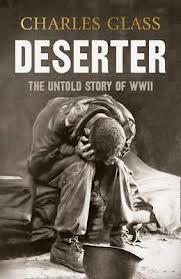
Eddie Slovik was the first to admit that he wasn’t “cut out for combat duty.” And for a time, the U.S. Army agreed.
The 24-year-old Detroit native was initially passed over for military service in World War Two because of a series of small time criminal convictions. But in January 1944, a dearth of fresh recruits compelled Uncle Sam to suddenly declare Slovik fit for the army. He was conscripted and underwent training as a rifleman.

By the end of the summer, Slovik arrived in war torn France with a batch of green replacements destined for the American 28th Infantry Division. The unit had suffered heavy losses during the Normandy campaign and needed fresh troops to bring it up to strength for the planned push into Germany.
On his way up to the front line, Slovik’s column came under heavy fire from enemy artillery. All of the recruits scurried for cover. When the barrage lifted, a terrified Slovik and another private slipped away from the group and made their way to the rear where they attached themselves to a Canadian unit. They remained there for six weeks before their hosts turned the two over to American MPs.
He reported to the commanding officer for the first time on Oct. 7, 1944.
The next day, the young rifleman requested a transfer to a rear echelon post explaining that he was too scared to serve on the line. When his commander refused him, the private openly declared to the platoon leader his intention to desert. The following morning, he made good on the threat abandoning his position and walking several miles to the rear. In the afternoon, he presented himself at the division’s headquarters with a hand-written confession of his desertion. In the note, he claimed that he was too scared to fight and asked for a transfer to a support unit.
A junior officer present told Slovik to tear up the note and return to his unit. The private refused, saying he’d sooner spend the war in jail than at the front. MPs placed him under arrest.
While in custody, a colonel advised Slovik to destroy the confession and head back to the line. Once more, Slovik refused. This time he was thrown into the stockade.
The divisional judge advocate met with the private and also urged him to reconsider. He even offered him a transfer to another rifle company. Slovik refused, saying he’d prefer a court martial.
On Nov. 11, Slovik was tried for desertion by nine staff officers. The panel spared no time finding him guilty and sentenced him to death by firing squad. Despite the speed and severity of the ruling, it was generally expected that the punishment would eventually be reduced to a prison term. Unfortunately, for Slovik, it didn’t work out that way.
With desertions on the rise, the divisional commander, Maj. Gen. Norman Cota, saw the sentence as an opportunity to stiffen the resolve of the rank and file. He refused to commute it. “If I hadn’t approved it,” Cota later said, “I don’t know how I could have gone up to the line and looked a good soldier in the face.”[1]
On Dec. 23, Slovik wrote to General Eisenhower seeking a Christmas reprieve. But with Allied desertions at an all time high following the Nazi’s surprise Ardennes offensive a week earlier, Ike was loathe to offer clemency. The decision sealed Slovik’s fate.
On the morning of Jan. 31, a mere 96 days before the end of the war in Europe, Pvt. Eddie Slovik from Detroit, Mich. was strapped to a post in a farmyard at Sainte-Marie-aux-Mines, France and shot to death by 12 riflemen.
Slovik was just one of 102 U.S. service personnel executed by military authorities during World War Two. He was however the only American soldier to be shot for desertion – the other condemned men were put to death for either rape or murder.

Despite this, according to the new book Deserter: The Untold Story by journalist and author Charles Glass, more than 40,000 American soldiers abandoned their posts during the war and nearly 100,000 British troops did the same.
Keith Lowe, who reviewed the book for the British newspaper The Telegraph points out that the number of World War Two deserters would have provided about 10 infantry divisions for the Allies.
Even with such staggering numbers, to this day, historians pay little attention to these wartime deserters. Yet, according to the author, what we think we know about these men is not always correct.
“Desertion is still synonymous with cowardice,” writes Lowe in his review. “But as Glass makes clear, there were actually dozens of reasons for abandoning one’s unit in the Second World War. Some men were indeed shirkers, but the vast majority simply needed a break from the constant strain of being under fire. Others were tempted away by the promise of wine, women or loot.”
Glass even reports how some soldiers in the rear echelon busted out of their units so they could actually go up to the front to fight. Others were simply insane.
Lowe details a number of cases of desertion from Glass’ book, explaining each deserter’s motives for quitting the fight and how they faced justice (if at all).
To read the full article, click here. To join the book’s own Facebook group, click here.
But don’t you run off just yet — here are some other interesting facts about military desertion:
- More than 21,000 American soldiers were convicted of desertion in World War Two. Most received stiff prison terms; 49 were handed death sentences. With the exception of Eddie Slovik, all of these condemned men had their sentences reduced.
- The German army was much tougher on deserters. The Wehrmacht executed some 15,000 soldiers for desertion during World War Two. Today, these men are remembered as victims of war. A monument to them was even erected in Ulm in 1988. “Desertion is not reprehensible,” it reads, “war is.”
- The number of German army executions pales in comparison to Russia’s record. More than 158,000 Soviet soldiers were put to death for fleeing their posts during the war. Others were confined to penal battalions, which was just as good as a death sentence. Stalin also ordered his armies to form “blocking detachments” that would be positioned just behind the front to mow down any soldiers that fled. “It takes a very brave man to be a coward in the Red Army,” Stalin once remarked.
- Executions for desertion and cowardice were much more common in the British Army during the First World War, than in the Second. Two hundred and sixty five Tommies were shot by firing squads between 1914 and 1918 for “desertion”, “cowardice” or “quitting their posts”. [2] Even falling asleep while on duty was punishable by death, as two British soldiers discovered in 1917. [3]
- Arthur Muntz of Dublin, Georgia wasn’t granted the benefit of a court martial after he deserted. A Confederate solider at the First Bull Run, the 22-year-old Muntz fired a single musket round and then panicked and fled the battle. After chasing the Yankees from the field, his own comrades pursued the wayward private into a nearby woods where they captured him and shot him on their own. It wasn’t until after the war that Muntz’s family learned his fate when one of his killers contacted them.
____________
If you’d like to receive alerts about the latest articles and posts, click on the link in the upper right margin marked “FOLLOW THIS BLOG”. And don’t forget to follow us on Twitter.










Found this when looking for a history of WW2 British soldiers who disappeared in Russia, an interest sparked after reading Fly For Your Life as a teenager many years ago. Is there anything specifically on this? Will follow up on Glass’ book. Thanks